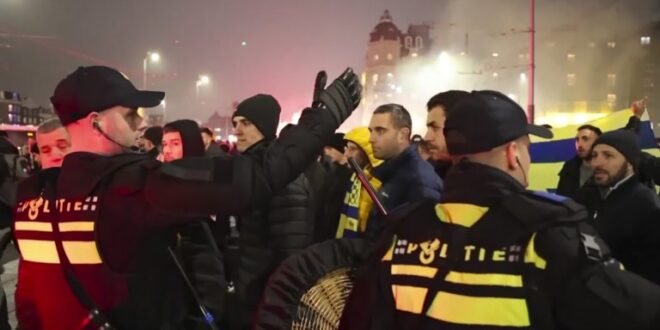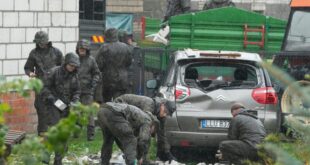Recent incidents in France, Germany, Belgium, and the Netherlands highlight the convergence of longstanding security challenges in Western Europe and emerging threats fueled by conflict in the Middle East.
The violence in Amsterdam surrounding the Israeli-Dutch soccer match earlier this month is a microcosm of the interplay between the ongoing Middle East conflict, domestic polarization, and narrative construction on social media.
A foiled copycat attack in Antwerp, Belgium, targeting the Jewish community, alongside security advisories issued by the Berlin Police Chief urging heightened vigilance for Jewish individuals in specific neighborhoods, underscores the alarming escalation of antisemitism.
Social media platforms have played a central role in amplifying these ripple effects, facilitating the spread of false and misleading information, fueling inspiration for copycat incidents, and enabling the coordination of violent actions.The Hamas attacks of October 7 and the Israeli retaliation, part of a broader regional conflict in the Middle East, have led to a drastic increase in antisemitic and Islamophobic incidents across Western nations. Deepening societal polarization – exacerbated by both non-state violent extremists and state actors – has created tensions throughout multifaith and multiethnic communities. Additionally, media and social media framing of the conflict and its secondary impact in the West has sometimes fanned the flames of polarization, potentially giving further oxygen to radicalization efforts by violent extremists and terrorists. The Soufan Center’s report released earlier this year, “Accelerating Hate: The Impact of October 7 on Terrorism and Political Violence in the West,” concluded that the Middle East conflict will have a long-lasting impact on the West, exacerbating preexisting challenges, and creating new ones. In some ways, what might otherwise be viewed as quotidian developments, are viewed through the lens of the conflict, which amplifies the severity and brings a global media focus on these actions.
Recent incidents in France, Germany, Belgium, and the Netherlands demonstrate the convergence of longstanding security challenges and emerging threats fueled by the Middle East conflict. These events have brought issues such as integration and identity to the forefront of public discourse and highlighted the challenges law enforcement faces in addressing violence linked to these issues. They also underscore the growing influence of social media in shaping compelling yet often misleading narratives about these ideologically motivated violent incidents, as well as the growing trend of minors being involved in these incidents. Of course, heightened tensions are not limited to Europe, similar polarization because of the conflict has occurred from Montreal to Melbourne, but these issues have grown particularly acute in Western Europe, especially over the past few months.
The violence in Amsterdam surrounding the football match between the Dutch Ajax team and the Israeli Maccabi’s on Thursday, November 8, demonstrated the complex interplay between the war in the Middle East, domestic tensions, and the importance of (social) media framing of violent incidents. Approximately 50 Maccabi fans removed a Palestinian flag from a private residence before the game and burned it, and engaged in other provocative, anti-Palestinian protest actions, as well as vandalism incidents after the football match, including attacking a taxi. In turn, this prompted a group of taxi drivers in Amsterdam to mobilize and violently confront a group of Israeli football fans. This quickly deteriorated into hit-and-run attacks against Maccabi fans and bystanders, leading to dozens injured and five individuals hospitalized. Rather than typical hooliganism, officials noted that there were threatening social media posts already present before the match and that attackers acted in a coordinated and intentional way against the Israeli soccer fans. At the same time, even if some of the incidents were premeditated, extremely incendiary singing, taunting, and chanting, which included barbs against dead Palestinian children, demonstrate how these situations can spiral out of control quickly and escalate to physical violence. Moreover, the initial reporting surrounding these events is often inaccurate or incomplete, colored by mis and disinformation and amplified by social media.
The violence in Amsterdam has been subject to various forms of information manipulation, with social media platforms having served to promote fake and deceptive narratives that have been used by both pro-Palestinian and pro-Israeli users. Numerous high-profile individuals, including former Israeli Prime Minister Naftali Bennet, called the incident a “pogrom,” conjuring some of the worst images of violence against Jewish people in Europe. Femke Halsema, the mayor of Amsterdam, also used that word to describe the violence, although she has since expressed regret for her choice of words, commenting this week, “I must say that in the following days I saw how the word pogrom became very political and actually became propaganda.” Uncontextualized video clips on social media allowed various ideologically driven distortions: some clips were said to show Maccabi hooligans, while other users promoted the clip, saying it showed pro-Palestinian mobs.
The violent incidents in Amsterdam were also examined through the lens of immigration. Dutch Prime Minister Dick Schoof noted that those responsible for the assaults on Maccabi Tel Aviv supporters in Amsterdam “predominantly came from a migration background,” meaning they, or their parents or grandparents, had origins outside of Europe. In the Netherlands, many individuals from migration backgrounds trace their ancestry to regions in the Middle East or North Africa. The ongoing conflict in the Middle East has sparked tensions between some of these communities and the Dutch government, which supports Israel’s right to self-defense but has condemned humanitarian suffering in Gaza.
While some analysts have framed the incidents in Amsterdam as isolated cases of hooliganism, arrests in Antwerp, Belgium, just days after the violence in Amsterdam, point to a broader and more concerning undercurrent of antisemitism. One 17-year-old was arrested and questioned for social media posts calling for a “jew hunt,” inspired by the events in Amsterdam, while five others were placed under administrative arrest. Antwerp is home to one of the largest Jewish populations in Europe, including a highly visible Orthodox Jewish population. The suspects coordinated their actions via Snapchat, highlighting how these plans are being organized through social media platforms across Western nations.
In the first week of November, a 16-year-old French teenager of Chechen origin was arrested for plotting a terrorist attack. The teenager had explored different targets for his attack, including the synagogue of Le Mans, a city in northwestern France. The number of minors implicated in terrorist attacks has increased significantly in 2023 and 2024, and young men of Chechen origin have been behind numerous plots in France. Additionally, soft targets such as synagogues have been especially targeted by terrorist plots in France since October 7.
In Berlin, Germany, Police Chief Barbara Slowik has issued safety advisories for both LGBTQ+ and Jewish individuals in certain neighborhoods. She underlined that there were no complete “no-go” zones in Berlin, but she advised that there should be more vigilance for these individuals in specific neighborhoods. The neighborhoods she listed were all predominantly Arab populations with a track record of antisemitism or hostility towards Jewish individuals.
Social media and communication platforms have been used in many of the cases of antisemitic and Islamophobic violent incidents in the past year in Western Europe. The developments in Antwerp have demonstrated that social media is not only a source of inspiration, leading to “copycat” attacks, but is effectively used to coordinate actions targeting communities in a coordinated fashion. Additionally, the trend of young individuals plotting terrorist attacks in Europe may partly be connected to their outsize use of social media, leading to more exposure to real, deceptive, and fake images and narratives related to the Hamas-Israel war that have proliferated online.
 Eurasia Press & News
Eurasia Press & News




